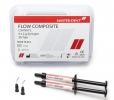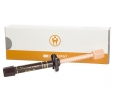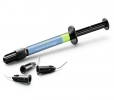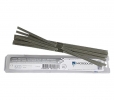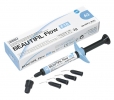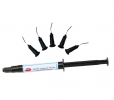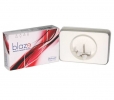Flowable composite is one of many categories of dental composite. “Flowables” are known for their excellent handling properties. They’re also known for increased polymerization shrinkage and reduced mechanical properties as compared to the other composite categories.
However, if you can count on one thing in dental materials, it’s change. Let’s take a closer look at this type of composite and how it can work for your practice. DPR spoke to three clinicians to get their take on flowable composites and how you can go with the flow in your practice.
The advantages of flowables
Flowable composites have a lower viscosity than their thicker counterparts. They can flow into the nooks and crannies of preparations that might otherwise be difficult to fill with a thicker composite. Flowable composites usually come in a syringe with a small-gauge needle to help them do their job in small preparations.1 Another advantage of the lower viscosity is flowables can form very thin layers, which prevents bubbles or voids in the material.2
The disadvantages of flowables
Of course, what makes flowables great for some restorations limits their effectiveness in others. The lower filler content of some materials can lead to more polymerization shrinkage.3 Also, when there’s less filler present, it can lead to a reduction in the composite’s mechanical properties.4
However, not all flowables are alike. Newer materials have higher filler contents than their predecessors, which improve some of the well-known disadvantages. These improved materials can be used for more than in the past and with similar results to more viscous composites.5
Flowables: suffering a bad rap from an inauspicious start?
Nathaniel Lawson, DMD, an assistant professor in UAB’s School of Dentistry’s division of biomaterials, thinks the reputation for reduced mechanical properties is just a bad rap for flowable composites. The materials are improving in strength and wear all the time.
When introduced in the ‘90s, the first flowables were more viscous because manufacturers reduced the filler content. Dr. Lawson estimates it was in the 50- to 60-percent range, which decreased their strength and wear properties. He says that reputation has stuck with flowables still today.
However, flowables in the post-2010s are 70 to 80 percent filled. Today, Dr. Lawson explains, flowable composites are approximating the mechanical properties of highly filled composites as far as strength and wear.
“Flowable composite is less viscous, so it adapts better. However, to get that flow, manufacturers had to take out some of the filler particles initially,” Dr. Lawson explains. “Now, they've manipulated the size of the particles, and that's how they've been able to obtain the different handling properties without reducing filler content. Also, that's how they've been able to maintain the strength.”

In 2015, Dr. Lawson and his team at UAB published a study in Operative Dentistry. The study compared the two-year recalls of both flowable and conventional highly filled composite resin in Class I restorations. Flowables had similar clinical performance after two years to highly filled composites in restorations of this type.
More recently, the team published a 2018 study, which reported similar performance of a flowable composite as a conventional, highly filled composite in “small- to moderate-sized occlusal restorations.”
“I'm not afraid to use flowables in posterior restorations. My hesitation in using them is if I have some area I want to sculpt because they don’t have great sculpting properties,” Dr. Lawson says.
However, Dr. Lawson says that some flowables have a slightly higher polymerization shrinkage percentage.
“The wear and strength of flowables have been improved, but the shrinkage hasn't been resolved. It's still an issue,” Dr. Lawson says.
According to the Journal of Conservative Dentistry, flowables need more study. The current literature on their success is too limited to make predictions about their long-term success.6
However, based on the research available at the time of publication (2017), the scientific evidence does suggest that flowables had similar clinical efficacy after three years to their conventional composite counterparts for both carious and noncarious lesions.7Furthermore, they perform well for occlusal cavity preparations, as sealants for pits and fissures, minimally invasive Class II restorations and noncarious cervical lesions.8
Outside of scientific study, however, flowables have their uses in your everyday practice. Here are a few ways our clinicians shared that you can use flowables to great effect in your direct composite restorations.
References
1. Baroudi, Kusai and Jean C Rodrigues. “Flowable Resin Composites: A Systematic Review and Clinical Considerations” Journal of clinical and diagnostic research : JCDR vol. 9,6 (2015): ZE18-24.
2. Ibid.
3. Ibid.
4. Ibid.
5. Shaalan, Omar Osama et al. “Clinical evaluation of flowable resin composite versus conventional resin composite in carious and noncarious lesions: Systematic review and meta-analysis” Journal of conservative dentistry : JCDvol. 20,6 (2017): 380-385.
6. Shaalan, Omar Osama et al. “Clinical evaluation of flowable resin composite versus conventional resin composite in carious and noncarious lesions: Systematic review and meta-analysis” Journal of conservative dentistry : JCDvol. 20,6 (2017): 380-385.
7. Ibid.
8. Ibid.

